Posted by Anita on 01.19.09 10:38 PM
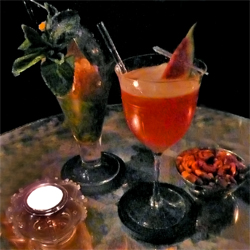 When you go to London, if you’re at all interested in the mixological arts, I recommend you bring an ample supply of cash, a large bottle of milk thistle, and a suitcase full of bubble wrap. Dear reader, they have so many wonders across the Pond that we only dream of Stateside.
When you go to London, if you’re at all interested in the mixological arts, I recommend you bring an ample supply of cash, a large bottle of milk thistle, and a suitcase full of bubble wrap. Dear reader, they have so many wonders across the Pond that we only dream of Stateside.
First among these treasures is a plethora of eye-poppingly gorgeous (not to say purse-poppingly pricey) cocktail establishments. The exchange rate is lately favourable to the American drinker, as much as can be possible. But a list of cocktails priced at £16, or £18, or even a heart-stopping £26 a sniff is bound to set even the hardiest of world travelers back on her heels. It was only the Christmas holidays and the attendant closure of many of the Capital’s top watering holes that saved us from coming home skint.
One of the key reasons for the allure of said establishments — apart from their five-star decor and their world-class staff — is the ability for a colonial to sample libations that simply never make it to our shores. Rare malts! Esoteric liqueurs! Cuban rums! The mind reels at the possibilities of the drinks that could be shaken, if only one had access to such wonders. (Happily, one does. Although London’s spirits emporia are small in number, they’re rich in merchandise, easily discovered, and more than happy to abuse your charge card in exchange for some very fragile cargo for the return flight.)
One of the best drinks we enjoyed while in London married both of these two alluring elements, the fantastically beautiful bar and the enticingly rare ingredient.
 Aided and abetted by another London treasure, Jay Hepburn — proprietor of the spectacular blog known as Oh, Gosh! — we spent an evening taxing the hospitality of not one but two of London’s luxury-hotel lounges, the Bar at The Dorchester and Connaught Bar. Though our night at The Dorchester will forever remain a highlight of our London trip (due in no small part to the extraordinary welcome we received from our gregarious barman, Stefano, and his flawless drinks that kept us so enraptured that we missed the last train of the night!), the Connaught was a stunner.
Aided and abetted by another London treasure, Jay Hepburn — proprietor of the spectacular blog known as Oh, Gosh! — we spent an evening taxing the hospitality of not one but two of London’s luxury-hotel lounges, the Bar at The Dorchester and Connaught Bar. Though our night at The Dorchester will forever remain a highlight of our London trip (due in no small part to the extraordinary welcome we received from our gregarious barman, Stefano, and his flawless drinks that kept us so enraptured that we missed the last train of the night!), the Connaught was a stunner.
It’s an opulent space, somehow embodying both splendid beauty and undeniably comfort. The staff are impeccable, gracious to a fault, and thoughtful to the utmost detail, from the first greeting to the last farewell. We were welcomed with a complimentary sip to enjoy while we perused the menu, then presented with a sheaf of recipes for the drinks we’d enjoyed at the end of the evening — an enchanting gesture that I hope will be the start of an international trend.
Though we savored many wonderful drinks that night, the final nod must go to the very first I tasted at Connaught Bar: a complex, spicy bit of exotica known as the French Sin. It’s not a simple drink to make, requiring a flavoured sugar, a barely seasonal fruit, a rare vermouth, and a carbonated tea infusion. Nevertheless, the rewards, as they say, are in the glass.
The French Sin also makes a perfect candidate for this month’s Mixology Monday: New Horizons, hosted by the anonymous Scribe of A Mixed Dram. Encouraged to sample a new spirit (amber vermouth, check!) or a new technique (carbonating tea — check again!), the French Sin covers all the bases. But if for some reason, you can’t be bothered to fizz your own tea, procure a bottle of rare vermouth, or infuse vanilla beans into sugar, never fear: The gentlemen of the Connaught Bar will be happy to oblige.

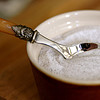

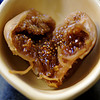
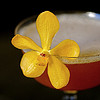
French Sin
– Connaught Bar, London
1/2 fresh fig
1/2T to 1T vanilla sugar
1-1/2 oz Armagnac
1/2 oz amber vermouth
3/4 oz lemon juice
3/4 oz rooibos spiced soda water
Muddle the fig in the shaker with the vanilla sugar, then add the rest of the ingredients — other than the spiced soda water — and shake with ice. Double-strain into a small goblet and top with rooibos spiced soda water, and stir briefly to combine. Garnish with a quarter of a fig.
—
If figs are out of season, look for the freshest dried figs available. Rehydrate them in a small amount of hot (not boiling) water until soft enough to muddle. For garnish, use a lemon twist or a yellow flower, reminiscent of a vanilla orchid.
Vanilla sugar can be purchased in gourmet shops or spice stores — Penzey’s makes a nice one, as does Nielsen-Massey. To make your own, grind a half of a dry vanilla bean in a spice grinder or coffee grinder with a small amount of granulated sugar. Add this vanilla powder to 1 cup sugar and let sit at least 24 hours (and preferably up to a week) before using. In this recipe, you can use the sugar as-is, since you’ll be straining the shaken mixture, but in baked goods or as a general sweetener, use a fine sieve to remove the larger pieces of vanilla pod after the infusing is complete.
To make the rooibos spiced soda, steep 4 tsp spiced rooibos tea (or 1T pure rooibos tea plus a few cardamom pods, whole peppercorns, and cloves) in a quart of hot water for 5 minutes. Strain, chill thoroughly, and charge in a soda siphon.
bar culture, coffee & tea, London, Mixology Monday, recipes
8 Comments »




Posted by Anita on 01.03.09 7:53 PM
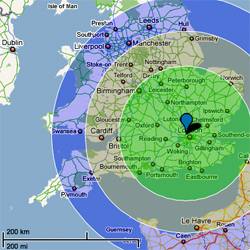 When you live on an island that’s a mere 300 miles wide, local food is a relative thing. In the map to the left, the blue pin shows the location of our London flat. The green circle — which touches the Normandy coast of France — shows a 100-mile radius; yellow encompasses 150 miles, and blue — which grazes Paris! — illustrates the 200-mile radius that many wintertime eat-local challenges allow.
When you live on an island that’s a mere 300 miles wide, local food is a relative thing. In the map to the left, the blue pin shows the location of our London flat. The green circle — which touches the Normandy coast of France — shows a 100-mile radius; yellow encompasses 150 miles, and blue — which grazes Paris! — illustrates the 200-mile radius that many wintertime eat-local challenges allow.
Looks like it would be easy to eat local, doesn’t it? I’m sure with a little practice and a bit of hunting, it definitely could be. But when you’re on holiday and have no understanding of where cities, counties, and postcodes are situated within Britain, it’s definitely a challenge. And when we discovered that most of London’s farmers markets run on a reduced schedule and roster for the run-up to Christmas, we thought we might have to call a vacation hiatus on making our weekly Dark Days meal from all-local ingredients.
Our biggest shock came on an afternoon trip to the world-famous Borough Market, the place we assumed would be the highlight of our shopping excursions. But although it’s still a feast for the eyes, it’s definitely taken on a more-corporate feeling since our last visit. And despite the wealth of delectables on offer, we found it nearly impossible to unearth items grown or produced local to London. One very pleasant exception: Mrs King’s gorgeous raised-crust pork pies are made in the appellation-controlled region of Melton Mowbray, about 90 miles from London.
Most of the bread we found, at Borough and in shops, was baked either on the outskirts of London, or in nearby Oxfordshire. Once we got a little basic geography under our belts, finding local ales and ciders was easy-peasy, even in the big supermarkets. And many well-regarded packaged products — preserves, pickles, mustards, crackers, cookies, and so forth — are made in Britain, if not within southern England per se.
 If you’re willing to leave the foodie haunts and supermarkets behind, the news gets better. FARMA-certified London Farmers’ Markets have some of the most thorough guidelines I’ve ever seen, touching on everything from permissible ingredients in artisan goods to animal welfare to to maximum distances traveled: Everything sold must be “raised, grown, produced, gathered, caught, or baked within 100 miles of the M25”, London’s exterior beltway. Even on a very slow week at the Marylebone Farmers Market, we were able to cobble together a full meal: Sausages (produced on Food Fore Thought‘s East Sussex farm, using their own-raised pork), Brussels sprouts, and potatoes, which we served with a store-bought bottle of real ale from Hook Norton in Oxfordshire, 81 miles from London.
If you’re willing to leave the foodie haunts and supermarkets behind, the news gets better. FARMA-certified London Farmers’ Markets have some of the most thorough guidelines I’ve ever seen, touching on everything from permissible ingredients in artisan goods to animal welfare to to maximum distances traveled: Everything sold must be “raised, grown, produced, gathered, caught, or baked within 100 miles of the M25”, London’s exterior beltway. Even on a very slow week at the Marylebone Farmers Market, we were able to cobble together a full meal: Sausages (produced on Food Fore Thought‘s East Sussex farm, using their own-raised pork), Brussels sprouts, and potatoes, which we served with a store-bought bottle of real ale from Hook Norton in Oxfordshire, 81 miles from London.
And in the world beyond all-local, the news is better still. Even in mainstream supermarkets like Waitrose and Sainsbury’s, it’s easy to find cage-free eggs and pastured chickens; a solid majority of carton eggs sold in the UK are cage-free. Thanks to many campaigns by celebrity chefs like Jamie Oliver and Hugh Fearnley-Whittingstall, Britons are by now far more aware of the intrinsic cruelty of the battery hen system than the average consumer here at home. And in England, organic certification — the kind you see stamped on supermarket chickens — means more. It’s not just a simple matter of feeding Chinese organic soy to your animals; the Soil Association (Britain’s main certification agency) guidelines call not just for a cage-free environment, but true “freedom to range”.
Lest you think this means a giant warehouse with a tiny door to a barren yard, the guidelines actually stipulate that birds may not even be permanently housed, and that their forage must be “well-covered with suitable vegetation”. And SA-certified poultry isn’t just something you’ll find in posh shops: Even on the New Year’s Day bank holiday, we had no trouble finding SA-certified organic chicken parts in a ‘Sainsbury Local’, a neighborhood grocery the size of a 7-11. We couldn’t find any evidence that this meat was local to us, but it was labeled “product of Britain”, as were many meat packages we saw and bought.
Despite handicaps of seasonality and familiarity, I feel like we were able to do quite well, rather easily. It’s hard to ignore the feeling that it feels easier to put together an ethical and reasonably environmentally sensitive meal in London than in nearly any other large city we’ve visited.
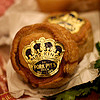


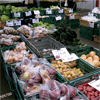

Dark Days challenge, farmers markets, locavore, London
4 Comments »




Posted by Anita on 12.28.08 6:34 AM
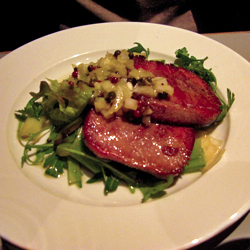 Even in the foodie heaven that is San Francisco, there’s no place like Konstam at the Prince Albert. A Victorian pub that’s been converted to a high-design jewelbox restaurant — it would take an entire paragraph just to explain the chandeliers-slash-draperies — Konstam toes the eat-local line with none of the obfuscation inherent in the standard “….whenever possible” disclaimer of Bay Area menus.
Even in the foodie heaven that is San Francisco, there’s no place like Konstam at the Prince Albert. A Victorian pub that’s been converted to a high-design jewelbox restaurant — it would take an entire paragraph just to explain the chandeliers-slash-draperies — Konstam toes the eat-local line with none of the obfuscation inherent in the standard “….whenever possible” disclaimer of Bay Area menus.
Even more impressively, Konstam’s sourcing radius is dramatically smaller than the usual 100-mile American definition: 85% of the kitchen’s ingredients, including flour and protein, come from the area covered by the London Underground and/or bounded by the M25 beltway, depending on where you’re reading. Either way, we’re talking about more or less 25 miles from central London.
One more thing: It seems that the idea to source ingredients locally was written into the restaurant’s plan before Chef Oliver Rowe really knew it was possible — but after a television deal had been signed. As a result, his tiny temple to seasonal and local food was well-known to British foodies even before the first meal was served. A two-week BBC miniseries called The Urban Chef documented the trials and tribulations of opening Konstam and finding suppliers. Watching video of Chef Rowe scouring the outer reaches of London feels like nothing so much as a giant, £300,000 dare… with the entire country watching each night on the telly.
 But enough about the schtick: How’s the food? Rowe wisely chose Northern and Central Europe as his inspiration, so even in the dead of an English winter, there’s sense to be made of the menu. A bowl of celeriac and apple soup came scattered with abundant hazelnuts, chunks of blue cheese, and a sprinkling of dill; the portion was far too large for such a dense porridge, but the flavors were lovely. Cameron enjoyed a starter of grilled Sevenoaks ox tongue, perfectly buttery-soft but meaty, garnished with a piquant pickled peppercorn relish atop a slick leek salad. It’s hard to choose which of our mains was the winner: Cameron chose perfectly charcoal-grilled leg of mutton, served with intensely vegetal chard and comforting colcannon. My own moan-inducing roast pork belly — complete with scored crispy crackling — came with both picture-perfect roast potatoes and a too-sweet cabbage compote.
But enough about the schtick: How’s the food? Rowe wisely chose Northern and Central Europe as his inspiration, so even in the dead of an English winter, there’s sense to be made of the menu. A bowl of celeriac and apple soup came scattered with abundant hazelnuts, chunks of blue cheese, and a sprinkling of dill; the portion was far too large for such a dense porridge, but the flavors were lovely. Cameron enjoyed a starter of grilled Sevenoaks ox tongue, perfectly buttery-soft but meaty, garnished with a piquant pickled peppercorn relish atop a slick leek salad. It’s hard to choose which of our mains was the winner: Cameron chose perfectly charcoal-grilled leg of mutton, served with intensely vegetal chard and comforting colcannon. My own moan-inducing roast pork belly — complete with scored crispy crackling — came with both picture-perfect roast potatoes and a too-sweet cabbage compote.
Although the wine list includes mostly Continental offerings, you can opt for a well-balanced choice of English wines from Kent, about 60 miles away, or pick from a great assortment of local ciders and ales from artisanal producers. We sampled the Sauvignon Blanc-like Chapel Down white and the funky Burrow Hill extra-dry cider; neither required the expected “pretty nice… for a local product” caveats.
Dessert was a modern take on traditional Victoria sponge — cake layered with cream and preserves — drizzled with vanilla syrup. Simple and exceedingly sweet, it would have been lovely with the espresso we ordered, but never received. And on that note: London will never be known for its stellar table service, but Konstam’s was even a step below the usual indifference. We were so happy with our food that we weren’t too troubled, but I can conjur a mood where we would have been furious at all the many issues with poor pacing, forgotten items, and long stretches of time where waitstaff simply disappeared — no mean feat in a restaurant the size of a large living room.
You could imagine Konstam being a worthwhile destination simply as a curiosity, a stunt-piece of a restaurant built on a conceit that might age poorly. But even without its locavore angle, the food delivers without offering (or requiring) any apologies for its constraints.
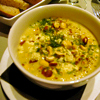
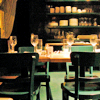
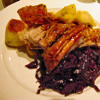

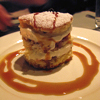
Konstam at the Prince Albert
2 Acton Street
London, WC1X 9NA
020 7833 5040
Dark Days challenge, locavore, London, restaurants
1 Comment »




Posted by Anita on 12.25.08 1:20 AM
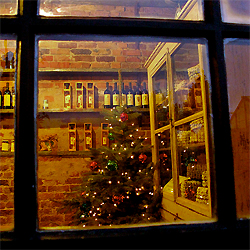 Happy Christmas, that is, from jolly old England! We’re having a blast on our vacation so far, eating lots of tasty food (fish & chips twice so far, both excellent), drinking pints of bitter in some gorgeous pubs, shopping at Borough Market, visiting with friends, and generally feeling very lucky to be in London at Christmas.
Happy Christmas, that is, from jolly old England! We’re having a blast on our vacation so far, eating lots of tasty food (fish & chips twice so far, both excellent), drinking pints of bitter in some gorgeous pubs, shopping at Borough Market, visiting with friends, and generally feeling very lucky to be in London at Christmas.
Speaking of luck: Don’t forget that today is the last day to bid on Menu For Hope raffle prizes. (Edited to add: The deadline’s been extended to 12/31!) If you have your heart set on winning our Ferry Plaza gourmet gift basket, the odds are still very promising. Be sure to check out Pim’s page for updates and new prizes that have been added along the way. There’s some good stuff in there that I’m sure someone on your last-minute present list would love to have a chance to win.
May your days be merry and bright!
holidays & occasions, London, Menu for Hope
3 Comments »




Posted by Anita on 12.23.08 3:27 AM
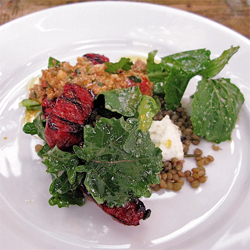 Here’s a recipe for a magical midwinter’s afternoon: Take the Tube to Richmond, a village on the fringes of London, then hop a red double-decker bus for a ride along the Thames. Alight in front of the cheery half-timbered pub, walk down the church lane past the Celtic stone crosses, left at the split-rail fence, and bob’s your uncle: You’ve arrived at Petersham Nurseries.
Here’s a recipe for a magical midwinter’s afternoon: Take the Tube to Richmond, a village on the fringes of London, then hop a red double-decker bus for a ride along the Thames. Alight in front of the cheery half-timbered pub, walk down the church lane past the Celtic stone crosses, left at the split-rail fence, and bob’s your uncle: You’ve arrived at Petersham Nurseries.
Now, even if an afternoon at a garden centre is not your idea of holiday time well spent, bear with me. Remember that the English excel at creating magical places, at planting beautiful gardens, at the eternal joy that is lunchtime. So it should come as no surprise that a mid-day repast inside a converted greenhouse — complete with dirt floors, mismatched chairs, and waitresses wearing muckboots with skirts — would be just the sort of adventure that would pay off very handsomely indeed.
Take your seat under the heater, and start with the seasonal sparkler — say, vanilla-rhubarb prosecco — then pick an appetizer to share. (If the chorizo starter with with lentils, caprini fresca, and agresto is on the menu, please order it; you won’t be sorry.) Pick your mains from a short list, one of which always seems to be vegetarian and another fish. Chef Skye Gyngell’s team “sources the best-quality seasonal ingredients that we can lay our hands on”, so you might opt for a whole roasted partridge with farro, chard, and salsa verde, or perhaps a fillet of sea bass served with clams, fino, arrocina beans, and aioli. Make sure to save room for dessert: The hazlenut tart comes with a generous drizzle of chocolate sauce and a dollop of airy crême fraiche.
Should you need to freshen up, you’ll find the loos in the hobbit-like wooden structure that houses the cafe kitchen and the teahouse. The latter — if you’ve neglected to book ahead, or just fancy a lighter nosh — offers a daily soup served with good bread and a hodgepodge of sweet cakes. And tea, of course. Always tea.
The nursery yard itself is full of all sorts of treasures, so if you’re a gardening buff — or, really, even if you aren’t — be sure to budget enough time to stroll and browse. The last lunch reservation is taken at 2:45, but the retail side remains open until 5pm, although in the dwindling light of wintertime you might plan to come early rather than stay late.
Bundle up and stroll back down the lane to the bus stop, where the diamond-paned windows of the pub now glow with holiday cheer. Your bus will be along promptly — this is England, after all — ready to whisk you back up the hill to Richmond and the real world… full, happy, and content.
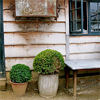



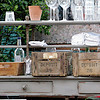
Petersham Nurseries & Cafe
Church Lane, off Petersham Road
Richmond
Surrey TW10 7AG
020 8940 5230
garden, locavore, London, lunch, restaurants, travel
3 Comments »




 When you go to London, if you’re at all interested in the mixological arts, I recommend you bring an ample supply of cash, a large bottle of milk thistle, and a suitcase full of bubble wrap. Dear reader, they have so many wonders across the Pond that we only dream of Stateside.
When you go to London, if you’re at all interested in the mixological arts, I recommend you bring an ample supply of cash, a large bottle of milk thistle, and a suitcase full of bubble wrap. Dear reader, they have so many wonders across the Pond that we only dream of Stateside. Aided and abetted by another London treasure, Jay Hepburn — proprietor of the spectacular blog known as Oh, Gosh! — we spent an evening taxing the hospitality of not one but two of London’s luxury-hotel lounges, the Bar at The Dorchester and Connaught Bar. Though our night at The Dorchester will forever remain a highlight of our London trip (due in no small part to the extraordinary welcome we received from our gregarious barman, Stefano, and his flawless drinks that kept us so enraptured that we missed the last train of the night!), the Connaught was a stunner.
Aided and abetted by another London treasure, Jay Hepburn — proprietor of the spectacular blog known as Oh, Gosh! — we spent an evening taxing the hospitality of not one but two of London’s luxury-hotel lounges, the Bar at The Dorchester and Connaught Bar. Though our night at The Dorchester will forever remain a highlight of our London trip (due in no small part to the extraordinary welcome we received from our gregarious barman, Stefano, and his flawless drinks that kept us so enraptured that we missed the last train of the night!), the Connaught was a stunner.



























